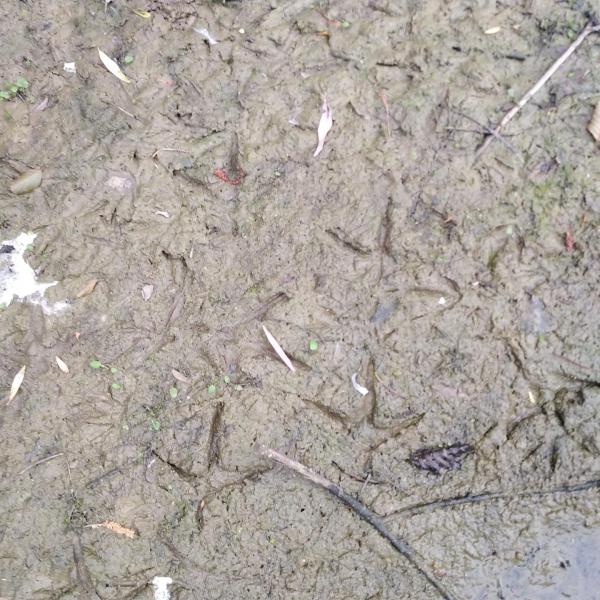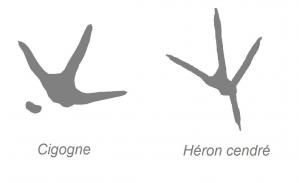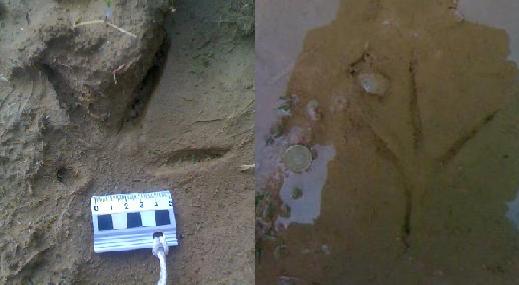Cigogne, Ciconia nigra
- Par pisteur
- Le 02/06/2013
- Dans Traces d'animaux et leur biologie / Animal Tracks and Biology
The Black Stork
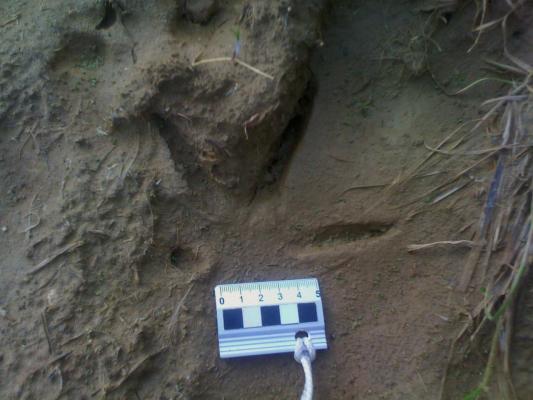 Trace de cigogne, découverte en bordure de rivière.
Trace de cigogne, découverte en bordure de rivière.
Dimensions : 10 x 14 cm (doigt postérieur non inclu)
Angle des doigts 2 et 4 : 113 °
Stork tracks discovered along the riverbank
Size : 10 cm x 14 cm (posterior toe non included)
(3.9 - 5.5 in.)
Outer toe angle : 113 °
Groupe d'empreintes.
Notez l'écartement des doigts très important : 140 degrés
Group of tracks
Notice the wide angle created by the outer toes : 140 degrees.
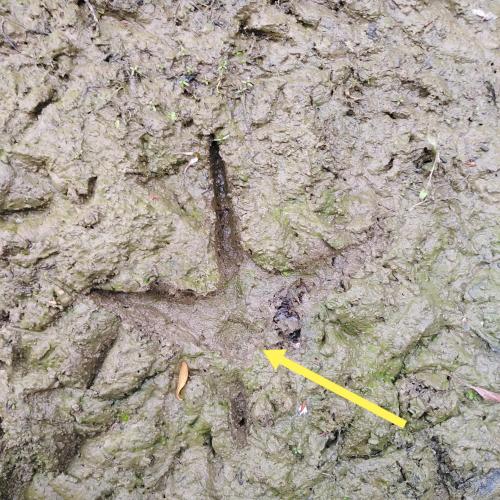 Une autre série d'empreintes trouvées sur un étang asséché,
Une autre série d'empreintes trouvées sur un étang asséché,
Dimensions : 16 x 15 cm
La zone centrale est souvent bien marquée (flèche jaune)
More tracks found on a dried-up pond
Size : 16 cm x 15 cm (6.3 - 6 in.)
The central area is often clearly marked (yellow arrow)
Foulée : 45 - 70 cm
La largeur de la voie est égale à la largeur de l'empreinte : 15 cm
L'oiseau marche comme un funambule en alignant parfaitement ses pieds
Trail of the bird
Stride : 40 - 70 cm (15.7 - 27.6 in.)
Bird's track straddle width equals the track's width itself.
It walks like a tighrope walker, placing it feet in perfect alignment.
 La forme générale de l'empreinte évoque celle d'un oiseau en vol
La forme générale de l'empreinte évoque celle d'un oiseau en vol
The overall shape of the tracks resembles that of a bird in flight
Héron et cigogne, comment les distinguer ?
Heron and stork, how to tell them apart?
Les doigts sont plus charnus chez la cigogne et sont terminés par des griffes arrondies. Le doigt 2 est plus court, créant une trace à l'aspect dissymétrique. Chez le héron les doigts antérieurs sont plus fins et moins écartés et il existe une palmure proximale entre les doigts 3 et 4 qui renforce l'aspect "tordu" du pied. Les griffes chez le héron sont plus longues.
L'hallux est nettement plus long chez le héron (env. 5 cm) et surtout fortement décalé par rapport à l'axe central de l'empreinte (1,5 cm de décalage). Chez la cigogne le doigt postérieur s'imprime sous la forme d'un trou rond ou d'une virgule fortement orientée vers le centre de la voie.
The toes are more fleshy on a stork and end with rounded claws. Digit 2 being shorter creates and asymmetric-shaped track.In herons, front toes are thinner and closer together, and there's a proximal webbing between digits 3 and 4 that adds to the twisted shape of the foot. Herons also have longer claws
The hallux (posterior finger) is noticeably longer on herons (about 5 cm) and significantly offset from the central axis of the track (1.5 cm). On storks the hind toe registers as a round hole or a heavily curved comma pointing towards the center of the trail.
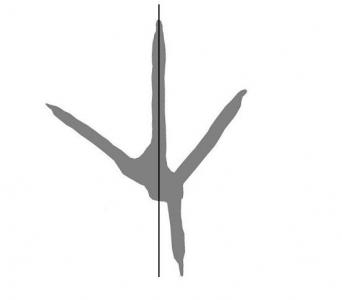 Décalage du doigt postérieur chez le Héron cendré (pied gauche)
Décalage du doigt postérieur chez le Héron cendré (pied gauche)
Ce manque d'alignement entre le doigt postérieur et les doigts antérieurs
permet une meilleurs stabilité dans un substrat profond ou glissant.
Un léger décalage existe pour la cigogne, mais il est nettement moins frappant
Offset of the hind toe on the Grey Heron's foot (left foot)
This misalignment between the hind toe and front toes allows
for greater stability on deep or slippery substrates.
A slight offset exists for the stork, but it is less pronounced
Les deux empreintes pour comparaison : cigogne à gauche ; héron à droite.
Si vous souhaitez en connaître davantage, sur la biologie et l'écologie de l'espèce : http://ciconia-nigra.over-blog.com/
For comparison purposes, the two tracks : stork on the left, heron on the right.
If you'd like to learn more about the species' biology and ecology, click the link provided.

